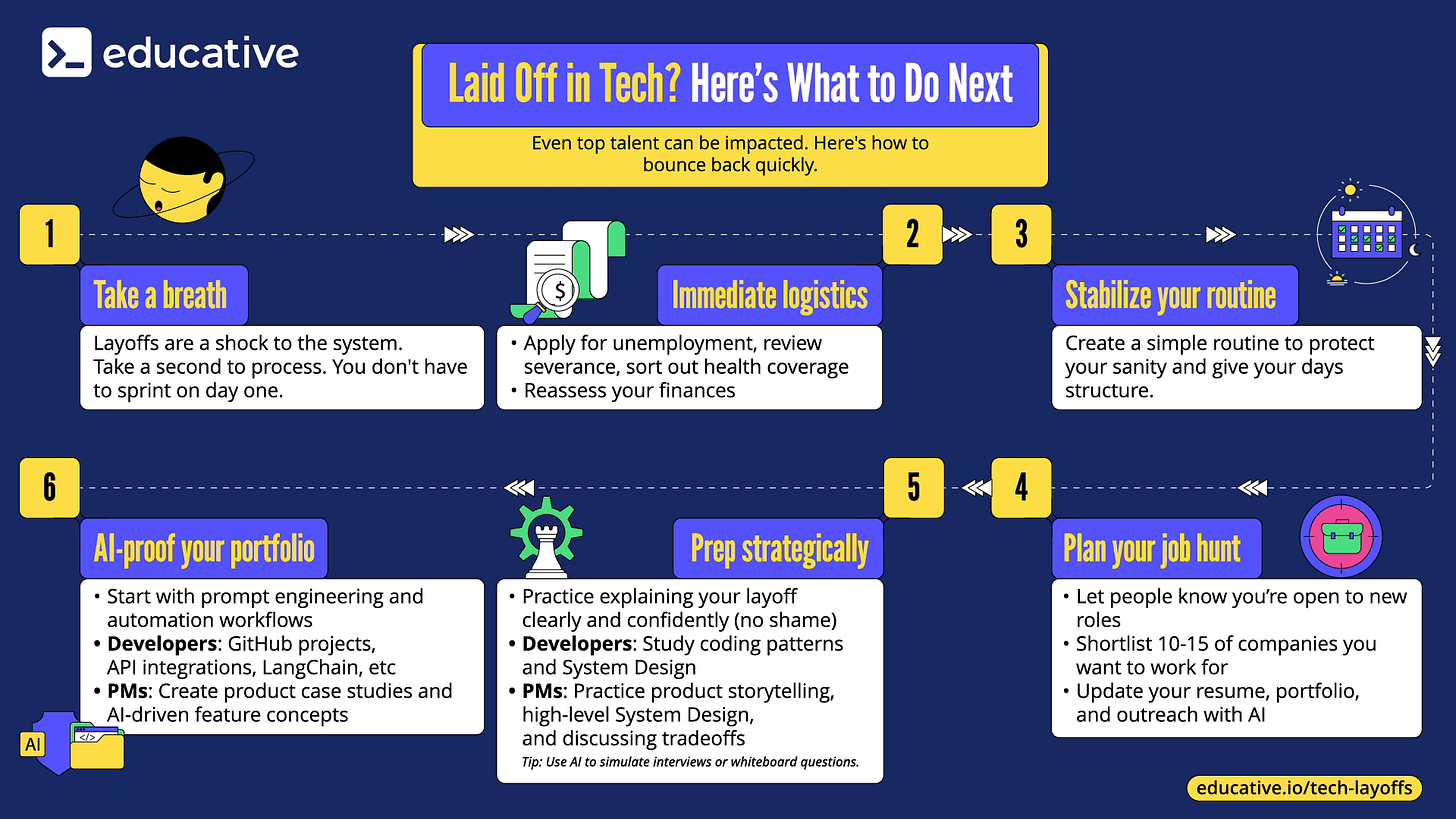The real story behind the Microsoft layoffs
As an ex-Microsoft SWE, I know firsthand that no matter what the corporate memos say: layoffs are not about talent.
Unfortunately, the Microsoft layoffs we've been hearing about for weeks have begun to rollout, impacting upwards of 6K people worldwide.
Having spent years inside Microsoft as a software engineer, I know firsthand that no matter what the corporate memos say, layoffs are not about talent. They're about budgets.
One of the best engineers I ever worked with was laid off at Microsoft in 2008 during another brutal cycle of cuts. It wasn’t about skill then, and it isn't about skill now.
If you were affected, I’m sorry. It’s brutal, even if you saw it coming. But you’re not powerless. And you’re not alone.
Today I want to offer a battle-tested framework you can use to bounce back after a layoff.
I'll cover:
6 steps to bounce back from a layoff
AI workflows to hack your job hunt
Specific guidance for devs and PMs
A few free upskilling resources to take advantage of
Not laid off? Stick around. This read will help you support your teammates, stay prepared, and prepare your safety net.
Your layoff recovery framework
1. Take a breath
Mute LinkedIn. Take a walk. Talk to a friend.
Layoffs can feel personal, even when they aren’t. Give yourself permission to process before jumping into action.
2. Handle the paperwork
These are all things you'll want to do in the first 72 hours:
Unemployment benefits: Apply right away. Some states move slower than a cold CI pipeline.
Severance review: Check pay details, stock vesting cliffs or acceleration terms, and non-compete clauses.
Health insurance: Weigh COBRA vs. marketplace plans.
Do a financial scan: What’s your buffer? Where can you reduce expenses without self-sabotaging?
Tidy logistics now = less chaos later.
3. Create a routine
Whether we know it or not, we all need structure in our days.
Create a simple daily routine:
Job hunt a little.
Skill up a little.
Move your body a little.
Connect with your network a lot.
Protecting your sanity is your full-time job right now.
4. Begin the job hunt
Start laying the groundwork before you’re “ready.” This is how momentum builds.
Let your network know you’re open to roles, whether on LinkedIn, in DMs, or in Discord.
Shortlist 10–15 companies you’d genuinely want to work for. Ignore prestige; chase alignment.
Tailor your materials using AI:
Use tools like ChatGPT or Teal to rewrite your application materials and craft company-specific outreach.
Train a model on your writing to maintain tone across applications.
5. Start interview prep
No, you don’t need to jump into 6 hours of LeetCode a day. But interview readiness isn’t something you want to cram last minute either.
Engineers:
Study problem patterns, not just problem volume (i.e., coding patterns > endless LeetCode drilling).
Strengthen your System Design intuition using real-world case studies.
PMs:
Refine your product storytelling: walk through a roadmap, tradeoff, or launch with clarity.
Practice articulating System Design decisions at a high level.
⚡AI Tip:
Simulate interviews and get personalized feedback with AI. You can practice everything from behavioral interviews to System Design diagramming in Educative’s AI Mock Interview Tool.
6. Futureproof with AI
The future of every tech job requires AI skills. Show you're keeping pace with the industry by building your AI skills.
Start with prompt engineering, then move on to applying AI in your workflow.
Engineers:
Build AI-infused GitHub projects
Prototype with LangChain
Automate repetitive workflows with APIs and agents
PMs:
Draft PRDs and feature briefs using AI
Brainstorm and validate AI-powered features or product concepts
Free resources to hit the ground running
Here’s a list of free resources that people in our community have leaned on when they needed them most:
System Design Handbook: My personal advice from 16+ years of experience in System Design Interviews at FAANG and beyond.
Grokking the Behavioral Interview: A free course with battle-tested frameworks, developed by ex-MAANG engineers.
Awesome Interview Questions: A crowdsourced GitHub list of interview Qs across stacks and roles.
OSS Port by OpenSauced: Connect with open-source projects looking for contributors. Build real things, with real impact.
Job Search Council: A free service that puts you in small groups with peer job-seekers. Swap resume feedback, stay accountable, and support each other in a Free Slack community.
Need something more comprehensive?
Our Tech Layoff Survival Kit is packed with actionable information for every round of the tech interview, including:
8 Week Interview Prep Roadmap
System Design Master Guide
Cheat sheets for Data Science, ML, AI, DSA, and more
Spared this round?
If you survived this wave, that's great... but don't coast. The best time to prep isn’t after the next layoff. It’s now:
Keep your resume current
Warm up your network
Skill up in short bursts
Layoffs don’t always come with a warning. Stay "almost ready."
You are not your layoff
You didn’t get here because you weren’t good enough, fast enough, or technical enough. You got here because someone upstairs needed to make a spreadsheet add up.
This was business, even if it feels very personal.
But here's the thing about tech workers:
We adapt. We rebuild. We push to prod (even after rollback disasters).
This? It’s temporary.
The market will bounce back. New opportunities will open up — often better aligned with who you are now, and who you’re becoming.
When they do, you won’t be starting from scratch.
You’ll be showing up sharper and more future-proof than ever before.
Need more resources?
Educative offers a range of tools and courses to help you with the post-layoff transition:
AI-Powered Mock Interviews: Coding, System Design, behavioral. Instant feedback.
Personalized Interview Prep Paths: Skip the noise. Complete an assessment and get a custom curriculum.
Cloud Labs and Projects: Build portfolio-grade, future-proof projects.
How else can we support you? From insider tips to frameworks, let me know what I can do to help.
– Fahim





